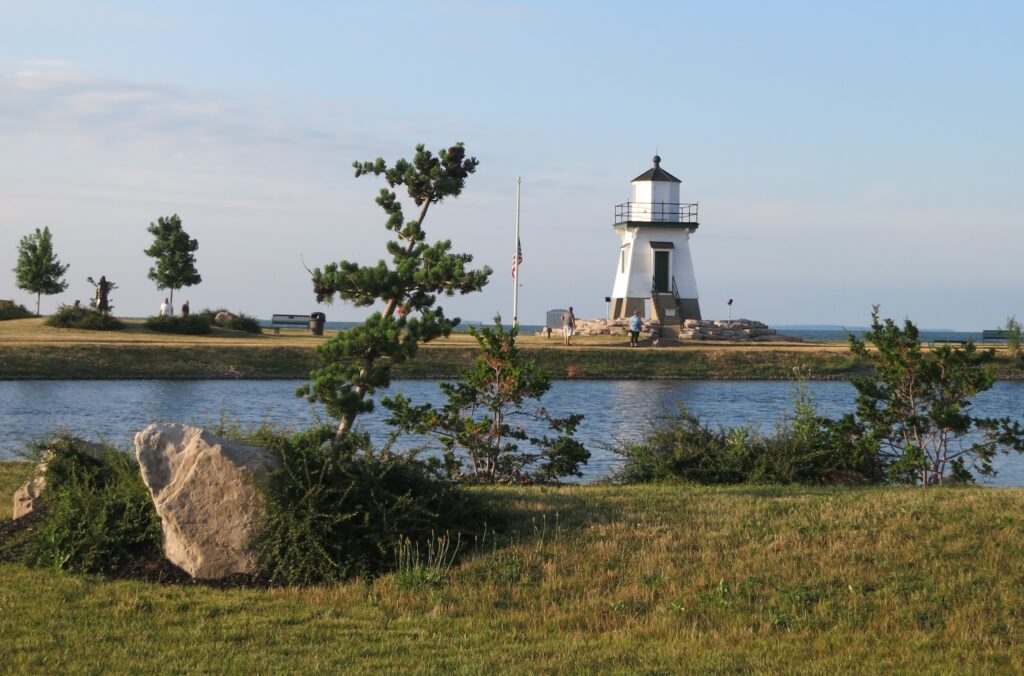Photos Courtesy of the Ottawa County Museum
A Rich Maritime Heritage

The city of Port Clinton has had an intimate connection with Lake Erie since it was first laid out in 1828. Located at the mouth of the Portage River, it was a shipbuilding port, thriving commercial fishing center, and home for many years to the famous Matthews Boat Company. Nowhere is Port Clinton’s rich maritime heritage more evident than in its unique lighthouses, the first constructed in 1833 to guide ships into the harbor. (See box at left—hopefully I have picture available.)
The lighthouse currently being restored is Port Clinton’s second. Constructed in 1896 at the end of the city’s West Pier at the Portage River entrance, the twenty-six foot structure remained active for more than thirty years. The first keeper was Robert Waterfield, who had been the last keeper of the old stone lighthouse. This new light, housed atop a 12’ x 12’ square sided pyramidal wooden structure, consisted of a 180- degree, curved, clear glass lens with horizontal ridges. A single kerosene lantern with a ruby chimney provided a steady red light visible for six miles. The intensity was doubled to 100 candlepower some years later.
To service the lighthouse from the east side of the river, a boat house was built behind the water works pumping station in 1902. This 18’ x 12’ wood-frame building was set on pilings along the break-wall. An iron oil house was erected on the West Pier in 1905, but was removed when the light was converted to electricity in 1926. Clarence “Rip” Perry was the last custodian of the lighthouse. The light was decommissioned in the late 1920s but the structure remained a welcome sight to locals and visitors alike until 1952, when Dave Jeremy removed the lighthouse to his marina (Brand’s Marina today), where it has stood to this day.
Now well over a century old, the Port Clinton lighthouse is an endearing reminder of the city’s rich maritime heritage.
Port Clinton’s First Lighthouse

The first lighthouse at Port Clinton was built in 1833 at the corner of Adams and Perry Street. It was a stone structure forty feet high with walls that were four feet thick at the base. Austin Smith, a Connecticut sea captain, was the first lighthouse keeper. The first child born in the keeper’s house next door was his granddaughter, Juliet Smith. The illuminating apparatus in the tower consisted of eight lamps using chimneys with wicks and bright reflectors placed behind the lamps. In 1855 the light was upgraded with a modern multi-prism sixth-order fresnel lens that required only one oil lamp for illumination. The lighthouse was decommissioned in 1870.
The old stone tower was demolished in 1899, to the dismay of local citizens. The house was razed in the spring of 1901 to make room for a new residence necessitated by the construction of a new lighthouse at the entrance to the Portage River in 1896. In the fall of 1901 the new keeper’s house was ready for occupancy.
The light keeper’s residence was sold by the U.S. Government to a local physician on May 25, 1927. Some years later the old keeper’s house became a restaurant. It operated for a number of years until it was gutted in a fire a few years ago. The site currently hosts a branch of a local bank.
The Vital Work of Restoration

For more than sixty years Port Clinton’s valiant little lighthouse has stood quietly though proudly on private property alongside the bank of the Portage River, largely forgotten until 2010, when the owner decided the aging light deserved a home along the Lake Erie shore once again. He began to explore the idea of transferring the lighthouse to city ownership, a process that led to the establishment the following year of the Port Clinton Lighthouse Conservancy (PCLC). Once the PCLC became organized, restoration work commenced. It soon became apparent, however, that restoration of the aging wooden structure would be protracted and costly, so the PCLC appealed to the community for help. The response was overwhelming. With the combined assistance of both personal contributions and grant moneys, restoration was completed in 2014. Once this historic structure has been moved to its permanent home on the waterfront, the PCLC will be vigilant in maintaining it for the benefit of present and future generations.
